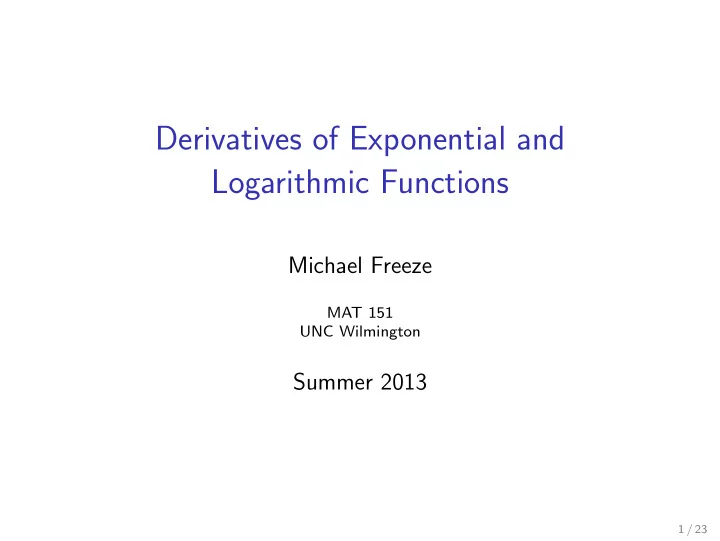

Derivatives of Exponential and Logarithmic Functions Michael Freeze MAT 151 UNC Wilmington Summer 2013 1 / 23
Section 4.4 :: Derivatives of Exponential Functions 2 / 23
Derivative of e x d dx ( e x ) = e x Example Find the derivative of y = 5 e x . 3 / 23
Derivative of e x d dx ( e x ) = e x Example Find the derivative of y = e x +7 . 4 / 23
Derivative of e x d dx ( e x ) = e x Example Find the derivative of y = x e x . 5 / 23
Derivative of e x d dx ( e x ) = e x Example e x Find the derivative of y = x +1 . 6 / 23
Derivative of a x For any positive constant a � = 1, d dx ( a x ) = (ln a ) a x Example Find the derivative of f ( x ) = 2 x . 7 / 23
Chain rule for exponential functions d � e g ( x ) � = e g ( x ) · g ′ ( x ) dx Example Find the derivative of y = e 3 x . 8 / 23
Chain rule for exponential functions d � e g ( x ) � = e g ( x ) · g ′ ( x ) dx Example Find the derivative of y = e x 2 − x . 9 / 23
Chain rule for exponential functions d � e g ( x ) � = e g ( x ) · g ′ ( x ) dx Example Find the derivative of y = − 3 e − x 2 +3 . 10 / 23
Chain rule for exponential functions d � e g ( x ) � = e g ( x ) · g ′ ( x ) dx Example Find the derivative of y = ( x 2 + x ) e 2 x − 1 . 11 / 23
Pollution Concentration The concentration of pollutants (in grams per liter) in the east fork of the Big Weasel River is approximated by P ( x ) = 0 . 04 e − 4 x , where x is the number of miles downstream from a paper mill that the measurement is taken. Find the following values. (a) The concentration of pollutants 0.5 mile downstream (b) The concentration of pollutants 1 mile downstream (c) The concentration of pollutants 2 miles downstream 12 / 23
Pollution Concentration The concentration of pollutants (in grams per liter) in the east fork of the Big Weasel River is approximated by P ( x ) = 0 . 04 e − 4 x , where x is the number of miles downstream from a paper mill that the measurement is taken. Find the rate of change of concentration with respect to dis- tance for the following distances. (d) 0.5 mile (e) 1 mile (f) 2 miles 13 / 23
Section 4.5 :: Derivatives of Logarithmic Functions 14 / 23
Derivative of ln x dx [ln x ] = 1 d x 15 / 23
Chain Rule for Logarithmic Functions dx [ln g ( x )] = g ′ ( x ) d g ( x ) Example Find the derivative of y = ln(8 x ). 16 / 23
Chain Rule for Logarithmic Functions dx [ln g ( x )] = g ′ ( x ) d g ( x ) Example Find the derivative of y = ln( x 2 − 3 x + 1). 17 / 23
Chain Rule for Logarithmic Functions dx [ln g ( x )] = g ′ ( x ) d g ( x ) Example Find the derivative of y = x ln x . 18 / 23
Chain Rule for Logarithmic Functions dx [ln g ( x )] = g ′ ( x ) d g ( x ) Example Find the derivative of y = ln( √ 4 x − 3). 19 / 23
Chain Rule for Logarithmic Functions dx [ln g ( x )] = g ′ ( x ) d g ( x ) Example 1 � � Find the derivative of y = ln . 3 x − 1 20 / 23
Logarithmic Differentiation Find the derivative of y = ( x + 4) 4 (3 x − 1) 2 . 21 / 23
Logarithmic Differentiation Find the derivative of √ 3 x − 1 y = ( x 2 + 2 x ) 3 . 22 / 23
Field Metabolic Rate The field metabolic rate (FMR), or the total energy expenditure per day in excess of growth, can be calculated for pronghorn fawns using Nagy’s formula, F ( x ) = 0 . 774 + 0 . 727 log x , where x is the mass (in grams) of the fawn and F ( x ) is the energy expenditure (in kJ/day). Source: Animal Behavior. (a) Determine the total energy expenditure per day in excess of growth for a pronghorn fawn that weighs 25,000 g. (b) Find F ′ (125 , 000) and interpret the result. 23 / 23
Recommend
More recommend